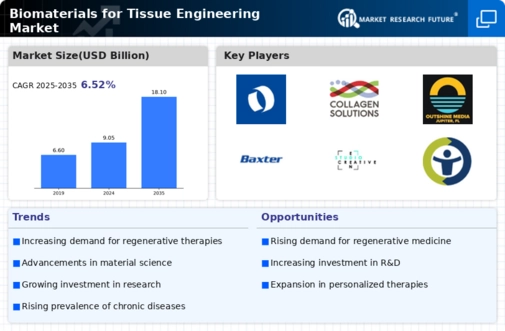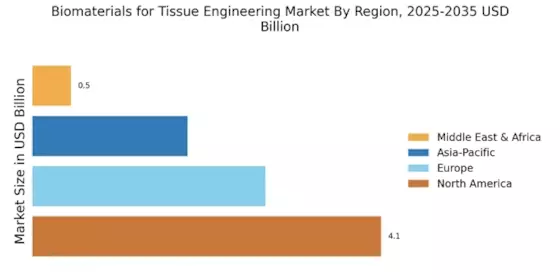Integration of Technology
The integration of technology into the Biomaterials for Tissue Engineering Market is reshaping the landscape of medical treatments. The incorporation of 3D printing technology allows for the precise fabrication of customized scaffolds tailored to individual patient needs. This technological advancement not only enhances the functionality of biomaterials but also reduces production costs and time. The market for 3D-printed biomaterials is expected to witness substantial growth, with estimates suggesting a valuation of over USD 1 billion by 2026. Additionally, the use of artificial intelligence in material design and testing is streamlining the development process, making it more efficient. As these technologies continue to evolve, they are likely to drive further innovation within the Biomaterials for Tissue Engineering Market.
Regulatory Support and Funding
Regulatory support and funding initiatives are emerging as key drivers for the Biomaterials for Tissue Engineering Market. Governments and regulatory bodies are increasingly recognizing the importance of biomaterials in advancing healthcare solutions. Initiatives aimed at streamlining the approval process for new biomaterials are likely to encourage innovation and expedite market entry. Additionally, funding from public and private sectors is being directed towards research and development in tissue engineering, fostering collaboration between researchers and industry stakeholders. This financial backing is essential for the development of novel biomaterials and their applications in clinical settings. As a result, the Biomaterials for Tissue Engineering Market is expected to benefit from enhanced regulatory frameworks and increased investment, driving growth and innovation.
Rising Awareness and Education
Rising awareness and education regarding the benefits of biomaterials are significantly influencing the Biomaterials for Tissue Engineering Market. As healthcare professionals and patients become more informed about the potential of biomaterials in tissue regeneration, the demand for these products is likely to increase. Educational initiatives aimed at healthcare providers are essential for promoting the adoption of biomaterials in clinical practice. Furthermore, public awareness campaigns highlighting the advantages of regenerative medicine are expected to drive patient interest and acceptance. This growing awareness is complemented by the increasing number of conferences and workshops focused on biomaterials and tissue engineering, fostering knowledge exchange among professionals. Consequently, the Biomaterials for Tissue Engineering Market is poised for growth as awareness and education continue to expand.
Advancements in Material Science
The Biomaterials for Tissue Engineering Market is experiencing a transformative phase due to advancements in material science. Innovations in biocompatible materials, such as hydrogels and scaffolds, are enhancing the efficacy of tissue engineering applications. These materials are designed to mimic the natural extracellular matrix, promoting cell adhesion and proliferation. As a result, the market is projected to grow at a compound annual growth rate of approximately 15% over the next five years. This growth is driven by the increasing need for effective solutions in regenerative medicine and the rising prevalence of chronic diseases. Furthermore, the development of smart biomaterials that respond to environmental stimuli is likely to open new avenues for research and application, thereby expanding the Biomaterials for Tissue Engineering Market.
Growing Demand for Regenerative Medicine
The rising demand for regenerative medicine is a pivotal driver for the Biomaterials for Tissue Engineering Market. As the global population ages, the incidence of degenerative diseases and injuries is increasing, necessitating advanced therapeutic solutions. Biomaterials play a crucial role in regenerative medicine by providing scaffolding for tissue repair and regeneration. The market is projected to reach USD 20 billion by 2027, reflecting a growing recognition of the potential of biomaterials in treating conditions such as osteoarthritis and spinal cord injuries. This demand is further fueled by increasing investments in research and development, as well as collaborations between academic institutions and industry players. Consequently, the Biomaterials for Tissue Engineering Market is poised for significant expansion in the coming years.


















Leave a Comment